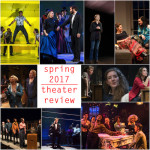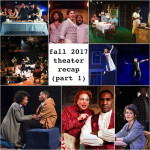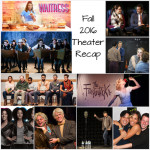Before fall is officially over, here is my final theater recap of 2017. In October I saw 12 shows in NYC: two musicals and ten plays. One was on Broadway, 11 were off-Broadway… because that’s where the best theater is. Ten of these shows have already closed but two are still playing (Puffs and In and of Itself). My reviews and a brief recap of each show follows.

 KPOP by Jason Kim, Helen Park, and Max Vernon (off-Broadway)
KPOP by Jason Kim, Helen Park, and Max Vernon (off-Broadway)
This was one of the harder tickets to score of the fall season, and with good reason — the unique concept of this immersive production is that the audience is part of a focus group to offer feedback on how Korean pop stars can cross over into mainstream American music. Upon checking in, every audience member is given a colored wrist band; this is how they divide us into groups after the opening number. In turn, we follow each of three different K-pop bands: a girl group (Special K), a boy group (F8 — pronounced “fate”), and a solo artist (MwE). We learn about the rigorous vocal and physical conditioning they must endure to keep their jobs. Gradually, the bright sheen of their branding wears off and we see the humans behind the K-pop star image. The experience is at first dazzling — big production numbers dripping with glitz and glamour — but we are asked to look deeper, and consider why these stars are not embraced by American pop culture. As part of the focus group we are questioned point-blank why this has been the case and the only answer that popped into my head was racism. Kudos to this creative team (Ars Nova, Ma-Yi Theater Company, Woodshed Collective) for providing depth beneath a glittery surface.
 F***ing A by Suzan-Lori Parks (off-Broadway)
F***ing A by Suzan-Lori Parks (off-Broadway)
This play and the next (In the Blood) were presented at Signature Theater this fall, intended to be seen as a tandem experience. Both were penned by playwright Suzan-Lori Parks around 1999 / 2000 — Parks describes them as having gestated together, as riffs of Nathaniel Hawthorne’s The Scarlett Letter. Each play works just fine as a stand-alone piece but watching both will invite deeper engagement with the ideas presented therein. In F***ing A, we meet Hester Smith, the local abortionist (movingly and memorably portrayed by Christine Lahti). A blood-red, scar-tissued “A” is emblazoned on her clavicle, visible at all times so that everyone she encounters will immediately recognize her disgraced profession, despite the fact that most people in town require her services at some point or another. She is working hard to earn money to get her son out of jail — he was imprisoned decades earlier on trumped up charges made by the current mayor’s wife. What follows is downright Greek tragedy (stop reading right now to avoid spoilers) — she ends up having to kill her adult son moments after uncovering his identity, and then unknowingly aborts her own grandchild. The audience sees it coming and feels the full weight of her unintended consequences. I was enraptured by this play and it will live in my memory as a favorite theater-going experience of 2017.
 In the Blood by Suzan-Lori Parks (off-Broadway)
In the Blood by Suzan-Lori Parks (off-Broadway)
A week later I saw Suzan-Lori Park’s other play, and it hit just as deeply. In the Blood centers on another Hester: Hester La Negrita, who lives under a highway bridge with her five children by five different fathers. The kids are played by adult actors who also take on other roles in Hester’s life — like a welfare caseworker, a skid row doctor, one of her baby daddies who is a sidewalk minister, etc. Each one takes advantage of Hester in various ways, and all of them abuse her sexually. The most poignant part of Hester’s plight is her persistent optimism: she insists that she just needs to get a leg up, to get a few extra dollars, and she can make things right again for her and her kids. But the set gives us a clue as to the futility of her situation: the concrete wall slopes upward and no matter how hard Hester and her children try to run up it, they can never reach the top.
 Torch Song by Harvey Fierstein (off-Broadway)
Torch Song by Harvey Fierstein (off-Broadway)
This show has been on my theater bucket list for awhile: Harvey Fierstein wrote it as a four-hour, three-act play called Torch Song Trilogy about a gay drag queen in New York City. It won him the Tony for Best Actor and Best Play in 1983. He has edited the play to under three hours running time in this updated version. Michael Urie takes over as Arnold in this version, but I could still hear Harvey’s singular voice coming through every line. We follow Arnold for a decade or so as he pursues love, fosters a gay youth, and confronts his overbearing mother. It’s a deeply moving journey and I felt so invested in these characters. I also really wanted to give Michael Urie a hug at the end, as I’ve seen him play struggling characters on-stage a few times these past few years and he pours all of himself into his roles. Torch Song is an important and memorable play and I hope this abridged version makes its way to regional theaters around the country.
 Puffs, or: Seven Increasingly Eventful Years at a Certain School of Magic and Magic by Matt Cox (off-Broadway)
Puffs, or: Seven Increasingly Eventful Years at a Certain School of Magic and Magic by Matt Cox (off-Broadway)
This show is a delight! Puffs chronicles all seven Harry Potter books in a fast-paced 100-minute stage play, as told through the perspective of the lesser-known Hufflepuff house at Hogwarts (which, for legal reasons, is abbreviated to Puffs — the tweaked names kept me laughing throughout). Harry and his mates are peripheral characters in this version as we follow the Hufflepuff main trio (Wayne, Oliver, and Megan) who struggle in the shadow of Harry’s fame. The show will appeal to all Potter fans, and likely even to Potter newbies. The staging is homespun and inventive; when the characters cast spells, we see magic unfurl in low-budget yet visually appealing ways. The terrific ensemble plays everything earnestly. This was a joy to sit through and I had a smile on my face the whole time.
 In and of Itself by Derek DelGaudio (off-Broadway)
In and of Itself by Derek DelGaudio (off-Broadway)
In and of Itself is both a magic show and a play — magician / actor Derek DelGaudio deftly combines genres by weaving his transcendent illusions with mesmerizing storytelling. The spell begins when we enter the hallway to the theater: there is a wall with hundreds of little white cards that say “I am a _____.” The blank space is filled with a different noun on every card — examples range from relationship roles (mom, godfather, caretaker) to professions (writer, scientist, beautician) to whimsical (stargazer, rambler, good luck charm) to cheeky (ninja, musketeer, gold digger). Every audience picks one; I chose the card “truth teller.” The cards are collected by an usher when you enter the theater and placed on a table for Derek to use throughout the show (there is some audience participation). I want to walk the tightrope here between describing the show without giving anything major away. Let me say this — my mind was repeatedly blown throughout the evening, and I don’t want to spoil it for myself by thinking too hard about how Derek accomplished such feats, because the only answer is lots of cameras, social media digging, and a hard-working team of people making things happen behind the scenes. He goes places you never expect, and the result is moving and extremely theatrical. (There is one standard card trick that I found plebeian in light of everything else.) This show has been extended well into 2018 and it’s worth your time, even if (or especially if) you lean towards more traditional theater.
 Prince of Broadway featuring the work of numerous composers (Broadway)
Prince of Broadway featuring the work of numerous composers (Broadway)
Hal Prince has directed some of the biggest Broadway hits of our time — Phantom of the Opera, Cabaret, Evita, Company, Follies, and dozens of other titles that even non-theater fans will recognize. This musical revue collects the best numbers from these shows into a 2.5-hour concert. I knew I wanted to get tickets because some excellent singers would be participating (Karen Ziemba, Michael Xavier, Tony Yazbeck) and for the reasonable price of a $30 rush ticket I was quite happy to listen to their renditions of these classic show tunes. But even though the vocals were fine, the show itself fell way short of expectations. It lacked a coherent vision. The only thing stringing the numbers together were pithy and unnecessary monologues delivered by alternating actors with glasses perched on their heads (Hal Prince’s signature look). At age 89, Hal Prince directed this tribute to himself, which seems odd to me. Perhaps the biggest sin of all is that it was boring. Years ago I missed Sondheim on Sondheim when it ran on Broadway and very much regretted it. That was not the case with this show; I could have skipped it without regret.
 Office Hour by Julia Cho (off-Broadway)
Office Hour by Julia Cho (off-Broadway)
In a nutshell: this is a play about gun violence in a university setting, inspired by the Virginia Tech shooting ten years ago. Shortly after buying my ticket, I received an email from the production that said something to the effect of “Please be aware there will be multiple, repeated gun shot sound effects throughout this play.” I replied to the email with two words: “Spoiler alert!” When I arrived at the theater, a similar warning was plastered on a sign outside the space. It got me thinking about an increasingly common dilemma for modern-era playwrights — in a time where we have to alert the audience in advance of any possible triggers (literal or otherwise), how do you build dramatic tension in your play? In the case of a show about a possible school shooting, the tension lies in the whether or not the gun will go off. So to reveal “multiple, repeated gunshots” to your audience in advance kills some of the suspense. I almost wonder if the playwright went overboard with the amount of gun violence (there is indeed a lot) to overcome the lack of surprise; it was an alternate way to ratchet up suspense. As the student/teacher meeting proceeds, we see gun violence erupt in the places you might expect it — as the troubled student reaches deep into his backpack, or after a particularly tense topic of conversation. These brutal, bloody moments indulge our expectations but are quickly followed by a brief black out during which the stage is restored to about 10 seconds prior, and we watch the scene continue as normal without any violence. It’s a handy storytelling device which highlights how easily our minds leap to the worst-case scenario — we have been trained by repeated real-life gun violence to anticipate the worst. This show is intense to sit through (85 minutes with no intermission) and it’s gripping after a clunky first scene that has too much exposition.
 Jesus Hopped the A Train by Stephen Adly Guirgis (off-Broadway)
Jesus Hopped the A Train by Stephen Adly Guirgis (off-Broadway)
This is one of two plays on this list set inside a men’s prison (the other is Oedipus El Rey). Angel is arrested after stabbing a religious cult leader in the ass — an injury which, while not intentionally fatal, led to a series of health issues that resulted in the cult leader’s death. While awaiting trail at Riker’s Island, Angel is placed in a cell next to a death row serial killer named Lucius. Lucius has found God and been born-again, spewing platitudes and reminders to be patient and forgiving even as a vengeful prison guard abuses him. Angel and Lucius’s cell block conversations contain some of the most powerful moments of the play — meditations on faith and redemption. Playwright Stephen Adly Guirgis won the Pulitzer in 2015 for Between Riverside and Crazy, a show I just saw in Los Angeles last month; I was pleased to experience this shows in the same time period and get a better grasp on his body of work. He is currently in residence at Signature Theater and I look forward to seeing more of his shows in 2018. It is worth noting that the two lead actors for Jesus Hopped the A Train were both replaced near the start of previews (it is unclear exactly why) so the fact that both Edi Gathegi (Lucius) and Sean Carvajal (Angel) are so at home in their roles is extra impressive.
 The Treasurer by Max Posner (off-Broadway)
The Treasurer by Max Posner (off-Broadway)
I wish I could warmly embrace this show as many theater critics have, but its impact did not land in the same way for me. The Treasurer is about a middle-aged man tasked with the burden of caring for his aging mother, a parent with whom he is both emotionally and geographically distant. He assists her financially from afar in a series of phone calls for most of the show until her inevitable decline brings him to visit in person. The playwright based the show on his father’s relationship with his grandma leading up to her death. The Treasurer reminded me a little of the last play I saw at Playwright’s Horizons, To Peter Pan on Her 70th Birthday, in that there is an unavoidable consequence when we watch an aging person approach the end of life on-stage — the audience can’t help but reflect on their own experience watching a loved one die. That personal memory becomes inextricably part of processing the play for each individual. The challenge for the playwright is how to balance the specifics of their story with the universal nature of its theme. As such, I didn’t glom onto the characters presented here, but instead relived parts of my own grandparents’ later years in synchronicity with the show.
 People Places Things by Duncan Macmillian (off-Broadway)
People Places Things by Duncan Macmillian (off-Broadway)
This show broke me apart and put me back together again. It’s about the rehab experience of an actress named Emma; the title refers to the main triggers for relapse — the people, places, and things that are likely to cause someone to use again. We first meet Emma (if that is even her real name) acting in a scene from The Seagull that quickly goes off the rails, as she is high as a kite. The morning after that disastrous performance she loads up on drugs one last time before checking herself into rehab. We follow the relentless roller coaster of her withdrawal and eventual relapse followed by a second attempt at rehab. Director Jeremy Herrin’s inventive staging brings Emma’s wretched journey to life in visceral ways: during her most intense moments, a half-dozen body doubles emerge to magnify her terror. Actress Denise Gough delivers the performance of the year as Emma — if her future career does not follow that of Kate Winslet or the like, then there is no justice. Her physical embodiment of an addict is downright canny; you can’t see any of the seams in her performance. She will grace the Broadway stage this spring in the London transfer of Angels in America.
 Oedipus El Rey adapted by Luis Alfaro (off-Broadway)
Oedipus El Rey adapted by Luis Alfaro (off-Broadway)
In this stirring tragedy, the Greek myth of Oedipus is set in the gang-run neighborhoods of South Central Los Angeles. When Oedipus is born to gang leader Laius and his wife Jocasta, a blind prophet tells Laius that one day his son will kill him. Laius preemptively orders his friend to murder his son for him, but the friend cannot arrange such a gruesome deed and instead secretly gives away the baby. Oedipus is raised nearby unknown to his birth parents. After a stint in prison in his late teens, he returns to South Central LA and immediately runs into his birth father, killing him in an altercation before either of them realize their blood connection. Then Oedipus meets Jocasta, and they have an instant connection. They have a fully nude, graphic sex scene on-stage during which the audience must sit with the uncomfortable knowledge that they are unknowingly mother and son. Eventually the truth of their identity comes to light and all involved meet a tragic ending: Jocasta dies at her own hand, and Oedipus blinds himself. The universal myth translates beautifully to this Latinx community in SoCal — the use of Spanish throughout especially grounds it in that culture. The set is noteworthy: with an impressive graffiti mural as a backdrop, bars of the men’s prison slide in and out between the action, a reminder that these characters cannot escape their fate.






